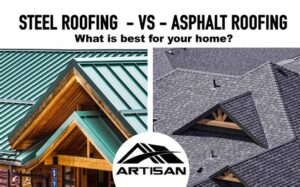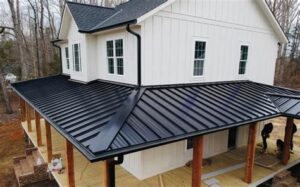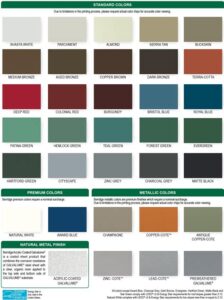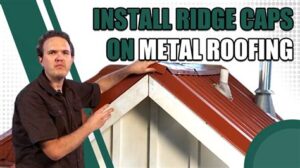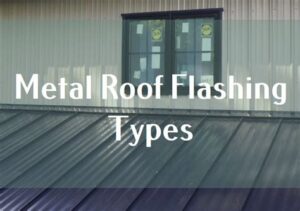10 Things You Didn’t Know About Standing Seam Metal Roof Details
As homeowners and builders increasingly seek durable and energy-efficient roofing solutions, standing seam metal roofs have emerged as a leading option. These stylish roofs not only enhance the aesthetic appeal of any structure but also offer remarkable longevity and performance. In this article, we will delve into the essentials of standing seam metal roofs, uncovering ten intriguing facts that many might not know. From their robust construction and impressive durability to common misconceptions and maintenance tips, this comprehensive guide will equip you with all the knowledge needed to make informed decisions about your roofing needs. Join us as we explore why standing seam metal roofs are becoming a popular choice for modern architecture and how they can benefit your home or building.
Understanding Standing Seam Metal Roof Basics
Standing seam metal roofing is a highly popular choice for both residential and commercial buildings, known for its aesthetic appeal and long-lasting durability. It consists of interlocking metal panels that are raised above the level of the roof, creating seams that run vertically from the ridge to the eaves. This design offers several functional advantages, including enhanced weather resistance and ease of installation.
The components of a standing seam metal roof typically include:
| Component | Description |
|---|---|
| Roof Panels | Metal panels that form the primary surface of the roof. They are usually made from materials such as steel, aluminum, or copper. |
| Seams | Raised sections where panels interlock, which help improve water drainage and minimize the risk of leaks. |
| Underlayment | Water-resistant material installed beneath the panels to provide additional protection against moisture. |
One of the key characteristics that set standing seam roofs apart is their ability to allow for thermal expansion and contraction. This feature is crucial in regions with varying temperatures as it helps prevent warping or cracking over time. Additionally, standing seam roofs can be installed with concealed fasteners, giving them a sleek appearance while providing superior protection against the elements.
These roofs are available in a variety of styles and colors, allowing homeowners to customize their look while maintaining functionality. Ultimately, the 10 things to know about standing seam metal roofs illustrate their robust performance and aesthetic flexibility, making them a prime choice for new constructions and renovations alike.
10 Things That Make Standing Seam Roofs Durable
Standing seam metal roofs are renowned for their resilience and longevity. Here are10 things that contribute to the durability of these roofing systems:
These factors collectively highlight the strength and durability of standing seam metal roofing, making it an excellent choice for homeowners looking for a long-lasting roofing solution.
The Advantages of Choosing Standing Seam Metal Roofing
Standing seam metal roofing offers a range of benefits that make it a superior choice for both residential and commercial applications. Here are some key advantages:
- Longevity: One of the most significant benefits of standing seam metal roofing is its long lifespan. Many metal roofs can last 50 years or more with proper maintenance, significantly outlasting traditional roofing materials.
- Durability: These roofs are designed to withstand harsh weather conditions, including heavy rain, snow, and high winds. The concealed fasteners also protect the seams from water infiltration.
- Energy Efficiency: Standing seam metal roofs can be coated with reflective finishes that minimize heat absorption, reducing cooling costs in warmer climates and improving energy efficiency.
- Low Maintenance: With fewer seams and joints compared to other roofing systems, standing seam roofs require minimal maintenance. Their ability to shed debris and snow further decreases the need for upkeep.
- Aesthetically Pleasing: Available in various colors, styles, and finishes, standing seam metal roofs can enhance the architectural appeal of a building while offering a modern touch.
- Eco-Friendly: Metal roofing is often made from recycled materials and is fully recyclable at the end of its lifespan, making it a sustainable choice for eco-conscious consumers.
- Fire Resistance: Metal roofs are highly resistant to fire, providing a level of safety that can lead to lower insurance premiums.
- Installation Flexibility: Standing seam roofs can be installed on a variety of roof slopes and shapes, making them versatile enough for almost any architectural style.
- Noise Reduction: Many standing seam metal roofing systems incorporate insulation options that significantly reduce noise from rain or hail, providing a quieter indoor environment.
The advantages of choosing standing seam metal roofing are numerous and encompass aspects of durability, maintenance, aesthetics, energy efficiency, and environmental impact. Whether you are considering a new roof or replacing an existing one, the 10 things to love about standing seam metal roofing make it a smart investment for any property owner.
Common Misconceptions About Standing Seam Metal Roofs
Standing seam metal roofs have gained popularity in recent years, yet several misconceptions persist regarding their characteristics and performance. Understanding these myths is essential for homeowners considering this roofing style. Here, we debunk some of the most common misconceptions surrounding standing seam metal roofs.
1. Standing seam roofs are too noisy during rain and hail. Many believe that metal roofs are excessively loud during rain or hailstorms. However, when installed correctly with appropriate underlayment and insulation, standing seam metal roofs can be quieter than other roofing materials.
2. Metal roofs are prone to rust. It is a common belief that metal roofs will rust over time. While exposed iron may corrode, most standing seam roofs are made from materials like galvanized steel, aluminum, or copper, which are treated to resist corrosion and rust.
3. They conduct heat excessively. Some homeowners fear that a metal roof will absorb heat and make their house hotter. In reality, many standing seam roofs are designed with reflective coatings that reduce heat absorption, keeping homes cooler.
4. Installation is too expensive. Although the initial investment in standing seam roofing may be higher compared to shingles, the long-term savings from durability, energy efficiency, and reduced maintenance costs make them a cost-effective choice over time.
5. All metal roofs are the same. There is a misconception that all metal roofing products are identical. In fact, standing seam metal roofs boast various profiles, materials, and finishes that can significantly influence performance and aesthetics.
6. Metal roofs are not suitable for all building styles. Many homeowners believe that metal roofs are limited to modern or commercial buildings. However, standing seam roofs can complement a wide range of architectural styles, from traditional to contemporary.
7. They attract lightning. A popular myth is that metal roofs attract lightning strikes. In reality, metal roofs do not increase the likelihood of a lightning strike, and if they do get struck, they actually conduct electricity safely underground.
8. There is limited color choice. Some potential buyers think that standing seam roofs come in a narrow selection of colors. In truth, manufacturers offer a broad palette of colors and finishes, allowing homeowners to find a perfect match for their home.
9. Standing seam roofs don’t hold up in extreme weather. This misconception overlooks the fact that standing seam roofs are designed to withstand severe weather conditions, including heavy snow, strong winds, and hail, due to their robust construction and interlocking panels.
10. They require complicated repairs. Finally, many assume that repairing metal roofs is complex and costly. However, qualified professionals can perform maintenance and repairs on standing seam roofs efficiently, often using simple methods.
By debunking these 10 things, we help homeowners make informed decisions about standing seam metal roofs. It’s essential to separate fact from fiction to appreciate the benefits of this roofing system fully.
How to Properly Maintain Your Standing Seam Roof
Maintaining your standing seam metal roof is crucial for ensuring its longevity and performance. Here are some essential tips for proper maintenance:
- Regular Inspections: Conduct regular inspections at least twice a year and after severe weather events. Look for any visible damage, loose fasteners, or areas where water may accumulate.
- Clean the Roof: Remove debris such as leaves, branches, and dirt from the surface and gutters. This prevents blockages and promotes proper drainage.
- Check and Maintain Sealants: Inspect the sealants around seams and edges for signs of deterioration. Reapply sealants as needed to prevent water infiltration.
- Examine Flashings: Ensure that all flashings are secure and free from rust. Replace any flashings that show signs of wear or corrosion.
- Keep Trees Trimmed: Trim back any overhanging branches to minimize potential damage from falling branches and to reduce debris accumulation.
- Avoid Walking on the Roof: Minimize foot traffic on your roof. If necessary, use proper ladders and scaffoldings to avoid damaging the metal surface.
- Professional Maintenance: Consider hiring a professional roofing contractor for periodic maintenance and inspections, especially if you notice any notable issues.
By following these guidelines, you can enhance the lifespan of your standing seam roof and avoid costly repairs in the future. Remember, proper maintenance is key to enjoying the full benefits of your investment in a standing seam metal roof.
Frequently Asked Questions
What is a standing seam metal roof?
A standing seam metal roof is a roofing system characterized by vertical panels with raised seams that interlock. This design allows for effective water drainage and minimizes the risk of leaks.
What are the benefits of a standing seam metal roof?
Standing seam metal roofs offer durability, energy efficiency, and low maintenance. They are also lightweight, fire-resistant, and can withstand extreme weather conditions.
How is a standing seam metal roof installed?
Installation of a standing seam metal roof involves securing metal panels to a substructure using clips, which allows for thermal expansion and contraction. Proper alignment and fastening are crucial for ensuring durability.
Can standing seam metal roofs be installed over existing roofs?
Yes, standing seam metal roofs can typically be installed over existing roofing materials, provided the structure can support the additional weight and proper ventilation is maintained.
What materials are used for standing seam metal roofs?
Common materials for standing seam metal roofs include steel, aluminum, copper, and zinc. Each material has unique properties to consider regarding cost, longevity, and maintenance.
Are standing seam metal roofs energy efficient?
Yes, standing seam metal roofs are considered energy efficient due to their reflective properties that can reduce heat absorption, resulting in lower cooling costs during hot months.
What is the lifespan of a standing seam metal roof?
The lifespan of a standing seam metal roof can range from 40 to 70 years or more with proper maintenance, making it one of the most durable roofing options available.

